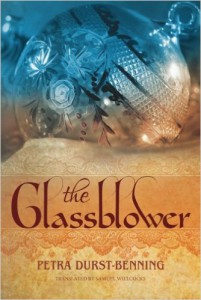Search the Blog
Categories
- Books & Reading
- Broadband Buzz
- Census
- Education & Training
- Friday Reads
- General
- Grants
- Information Resources
- Library Management
- Nebraska Center for the Book
- Nebraska Libraries on the Web
- Nebraska Memories
- Now hiring @ your library
- Preservation
- Pretty Sweet Tech
- Programming
- Public Library Boards of Trustees
- Public Relations
- Talking Book & Braille Service (TBBS)
- Technology
- Uncategorized
- What's Up Doc / Govdocs
- Youth Services
Archives
Subscribe
Tag Archives: Friday Reads
Friday Reads: A is for Alibi by Sue Grafton
O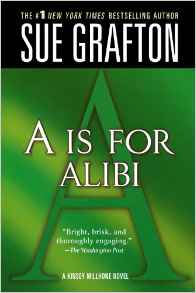 ne year for Christmas I asked everyone to give me a copy of their favorite book; just one book and hopefully an explanation of why it held that honor. This was well over 20 years ago and my college roommate gave me a copy of A is for Alibi by Sue Grafton. One of the many librarian stereotypes is that we love mysteries so I’d avoided this genre but I read it and I liked it. Sue’s books saved me on a dreadful flight when I was sick and a horrible vacation and the fictional character Kinsey Millhone became a good friend. She’s a low-maintenance, hard-driving, common sense kind of woman whose luck in love has sometimes been similar to my own. If you are a series reader and have yet to read Sue’s books, the book club collection may be just the ticket. The order could not be any easier to understand: A is for Alibi; B is for Burglar; C is for Corpse and on and on through the most recent release X. In the series, Henry Pitts plays Kinsey’s friend and landlord and is a favorite character of mine with the runner up being Rosie who runs the local restaurant and bar where Kinsey often has dinner or meets clients. You may want to know that Sue has adamantly said no to ever selling her rights to turn this series into a movie which actually pleases me because the characters will always stay in my mind, tidy as you please with no alterations from Hollywood. Here is a list of the titles so you can make your reservation.
ne year for Christmas I asked everyone to give me a copy of their favorite book; just one book and hopefully an explanation of why it held that honor. This was well over 20 years ago and my college roommate gave me a copy of A is for Alibi by Sue Grafton. One of the many librarian stereotypes is that we love mysteries so I’d avoided this genre but I read it and I liked it. Sue’s books saved me on a dreadful flight when I was sick and a horrible vacation and the fictional character Kinsey Millhone became a good friend. She’s a low-maintenance, hard-driving, common sense kind of woman whose luck in love has sometimes been similar to my own. If you are a series reader and have yet to read Sue’s books, the book club collection may be just the ticket. The order could not be any easier to understand: A is for Alibi; B is for Burglar; C is for Corpse and on and on through the most recent release X. In the series, Henry Pitts plays Kinsey’s friend and landlord and is a favorite character of mine with the runner up being Rosie who runs the local restaurant and bar where Kinsey often has dinner or meets clients. You may want to know that Sue has adamantly said no to ever selling her rights to turn this series into a movie which actually pleases me because the characters will always stay in my mind, tidy as you please with no alterations from Hollywood. Here is a list of the titles so you can make your reservation.
Friday Reads: My 2015 Reading Challenge
For 2015 I set a personal reading challenge of 120 books. It seemed like an attainable goal; in 2014 I completed 100 books, and I read for the Golden Sower Awards voting committee, so I go through a LOT of intermediate-level books in the spring. And really, what’s 10 books a month, right? But life happens, as it always does, and sometimes life hands you a newborn that kicks books out of your hands when you try to read in the evenings… I got a little behind in my reading pace over the summer. I got back on track and finished my 120th book on December 31st.
I read for pleasure mainly, but also for enlightenment, or distraction, or because my son or husband beat me to the remote control. I’m not a picky reader: there were memoirs, mysteries, poetry, science fiction, fantasy, classics, humor, short stories, political issues, historical fiction, information science, chick lit, and graphic novels. There was a book on economics, (Adam Smith, anyone), several on parenting, one about dressing better, many about celebrities, and also many about mice and their adventures (I read to a 5 year old). I read in all formats – good ol’ print, eBooks, and audio. The beauty of such a lofty goal (for me) was that I didn’t allow myself to be choosy. If it piqued my curiosity, I read it. Quite a few titles I waited months on reserve for at my local library, but just as many were impulse grabs. Only a couple earned me fines for late return…
Out of 120 books, there were bound to be a few that I loved and some that I could have done without. I’ve shared a couple so far this year in our Friday Reads feature (Ready Player One, After the Golden Age), and here I will mention a couple more:
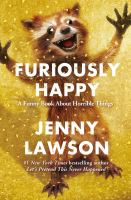
If you want to laugh until you cry: Furiously Happy: A Funny Book About Horrible Things, by Jenny Lawson. The author is deeply depressed, but doesn’t let it get her down. (New York: Flatiron Books, 2015. ISBN 1250077001)
If you just want to cry: Between the World and Me, by Ta-Nehisi Coates. This book made me sad for all of humanity. I took a couple of days off from reading after this. (New York: Spiegel & Grau, 2015. ISBN 0147520509)
 If you want to cringe: The Nest by Kenneth Oppel. This one had me listening for the buzzing of small insects. Aimed at the upper-elementary set, but creepy enough for us older kids too. (New York: Simon & Schuster Books for Young Readers, 2015. ISBN 148143232X)
If you want to cringe: The Nest by Kenneth Oppel. This one had me listening for the buzzing of small insects. Aimed at the upper-elementary set, but creepy enough for us older kids too. (New York: Simon & Schuster Books for Young Readers, 2015. ISBN 148143232X)
 If you want to cheer for the underdog: The Martian, by Andy Weir – read it before you see the movie. Or better yet listen to it -the Brilliance Audio version has R.C. Bray narrate to great effect. (Grand Haven, MI: Brilliance Audio, 2014. ISBN 9781491523216)
If you want to cheer for the underdog: The Martian, by Andy Weir – read it before you see the movie. Or better yet listen to it -the Brilliance Audio version has R.C. Bray narrate to great effect. (Grand Haven, MI: Brilliance Audio, 2014. ISBN 9781491523216)
 If you loved “one of the greatest love stories ever told”: As You Wish: Inconceivable Tales From the Making of The Princess Bride, by Cary Elwes. First watch the movie, then read the book. Then watch the movie again. I went the audiobook route again – narrated by the author. (New York: Simon & Schuster Audio, 2014. ISBN 9781442383456)
If you loved “one of the greatest love stories ever told”: As You Wish: Inconceivable Tales From the Making of The Princess Bride, by Cary Elwes. First watch the movie, then read the book. Then watch the movie again. I went the audiobook route again – narrated by the author. (New York: Simon & Schuster Audio, 2014. ISBN 9781442383456)
Did you set a reading goal this past year? Are you aiming for a certain number in the year to come?
Happy New Year everyone – looking forward to many more great books in 2016!
Friday Reads: Becoming Nicole: The Transformation of an American Family, by Amy Ellis Nutt
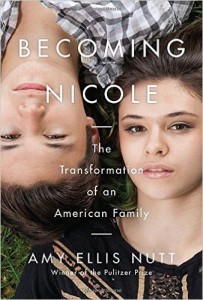 Becoming Nicole: The Transformation of an American Family, was released on October 20, 2015, two weeks before the Houston Equal Rights Ordinance was defeated in large part due to fears generated over bathroom access by transgender individuals. I learned about the book through the flurry of news coverage immediately preceding its release, and I was first in line for Lincoln City Library’s print copy. Written by Amy Ellis Nutt, it tells the story of the Maines family who, in January 2014, won a landmark civil-rights case against the Orono school district after school officials denied their transgender daughter Nicole the right to use the girls’ restroom.
Becoming Nicole: The Transformation of an American Family, was released on October 20, 2015, two weeks before the Houston Equal Rights Ordinance was defeated in large part due to fears generated over bathroom access by transgender individuals. I learned about the book through the flurry of news coverage immediately preceding its release, and I was first in line for Lincoln City Library’s print copy. Written by Amy Ellis Nutt, it tells the story of the Maines family who, in January 2014, won a landmark civil-rights case against the Orono school district after school officials denied their transgender daughter Nicole the right to use the girls’ restroom.
The value of this book at a time when every news story about transgender rights results in a flurry of mean-spirited comments is that it tells the story of a transgender child and her family from day one. It allows those of us who have no personal experience with being transgender or raising a transgender child to glean, just a little bit, through the power of story and the willingness of the Maines’ family to share theirs, what it might be like.
The story begins in 1997 when Wayne and Kelly Maines adopted identical twin boys named Wyatt and Jonas. Despite having the same DNA and being raised in the same household, the boys identify differently from early on. Even before he’s three Wyatt prefers girl things and displays distress over being treated as a boy. The anecdotes shared to illustrate this early dissonance are poignant and heartrending.
By the time the boys are three Kelly is already doing research, trying desperately to understand what is going on with Wyatt. Wayne, on the other hand, is deeply uncomfortable with Wyatt’s gender nonconformity and disapproves of Kelly’s willingness to partially accommodate the boy’s toy and clothing preferences. Although Wayne clearly loves both boys, his initial response is to withdraw and leave the reins primarily in Kelly’s hands.
Interestingly enough, at least early on the boys’ friends and classmates had the fewest problems with their differing gender identities: Wyatt had no problem making female friends and bonding with them over “girl” things; the son of a family friend contradicted his mother when she referenced the “Maines boys,” telling her that Jonas is a boy and Wyatt is a girl; and at one point, when the twins are nine, Jonas tells his dad to face the fact that he has a son and a daughter.
It wasn’t until fifth grade, when the grandfather of a classmate complained about a boy using the girls’ restroom, something Wyatt (now Nicole) had been doing with school approval for some time, that things got bad. In response to the complaint and ongoing harassment by the boy whose grandfather had lodged it, the school eventually told Nicole she had to use a staff restroom. The continuing conflict and increasingly hostile school climate began to take a toll on the family, and in 2009 they decided Kelly and the twins would relocate to Portland. They also filed their initial lawsuit against the school district.
Although this was a difficult time for the family financially and emotionally, it was also a turning point for Wayne who realized he needed to step up to the plate and begin advocating for his daughter. He became the more public face of the family, eventually giving speeches, writing letters and essays that appear in national publications, and lobbying politicians. In this sense, the story of Nicole’s transformation is also the story of her father’s transformation as he opened himself to a reality unfolding in front of him that contradicted his expectations and beliefs.
Nutt, Amy Ellis. Becoming Nicole: The Transformation of an American Family. New York: Random House, 2015.
Friday Reads: The Storied Life of A. J. Fikry by Gabrielle Zevin
 The Storied Life of A. J. Fikry by Gabrielle Zevin (Algonquin Books, 2014) What reader doesn’t love a story set in a bookstore? …especially a quirky, little independent bookshop in a purple Victorian cottage on Alice Island where the faded sign reads:
The Storied Life of A. J. Fikry by Gabrielle Zevin (Algonquin Books, 2014) What reader doesn’t love a story set in a bookstore? …especially a quirky, little independent bookshop in a purple Victorian cottage on Alice Island where the faded sign reads:
Island Books
Alice Island’s Exclusive Provider of
Fine Literary Content since 1999
No Man Is an Island; Every Book Is a World
Within the first ten pages of this book, the reader is transported to a place where time is trying to stand still, but of course it won’t. We are immediately introduced to a curmudgeonly bookshop proprietor (A.J Fikry), an eager young publishing representative (Amelia Loman), and a tragic set of circumstance that creates tension between the two of them from the beginning. Fikry is reeling from the loss of his beloved wife and he’s not really coping with his grief and loss. The store isn’t exactly thriving either. We meet Fikry just as his life is about to change dramatically. He suffers another devastating loss and gains a reason to live in the space of a few short weeks.
As the story unfolds, we meet more of the residents of Alice Island and the characters in this book are very well written, interesting, and endearing—with lots of juicy dialog between them. We come to care about them and their community and it goes without saying, we are rooting for Fikry to pull himself together. The writing is clever and crisp and I love a good convention in a book and this one has one—each chapter is introduced with a short book review suitable for a printed shelf-talker. Sometimes it takes until the end of the chapter to figure out what the review had to do with the action in the chapter, but that just makes it more fun. A side benefit of this setup is that I got a bunch of recommendations of books to read.
This is a great selection for a book club, makes a great gift for a reader in your life, and I promise it’s a page-turner.
Mary Jo Ryan
Friday Reads: The Naked Mountaineer
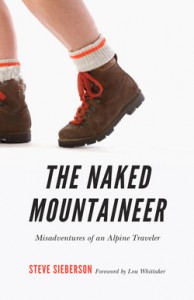 Steve Sieberson is a world traveler – and a mountaineer. His law career has taken him to numerous foreign places. His expertise in international business has included lecturing and advising. In 2006 he joined the Creighton University Law School faculty. Sieberson’s writing includes a recent textbook on international business contracting. But for those of us not closely connected to international business his book on mountaineering is a much more interesting read.
Steve Sieberson is a world traveler – and a mountaineer. His law career has taken him to numerous foreign places. His expertise in international business has included lecturing and advising. In 2006 he joined the Creighton University Law School faculty. Sieberson’s writing includes a recent textbook on international business contracting. But for those of us not closely connected to international business his book on mountaineering is a much more interesting read.
I met Steve Sieberson and his wife Carmel at an Omaha Public Library book event. It was there that I picked up a copy of his book, The Naked Mountaineer: Misadventures of an Alpine Traveler (University of Nebraska Press). Outside of his years as a practicing attorney and international businessman, Sieberson developed a passion for mountaineering. A family trip one summer from his rural home in northwest Iowa to Colorado began his lifetime fascination with high elevations. From there he read books on mountaineering, books that he found at his local library. His boyhood fascination has endured through his adult years.
Sieberson’s move to Seattle and his many years there provided the proximity to enjoy his passion for the mountains of the Pacific Northwest. During his years in Seattle he was a member of Seattle Mountain Rescue and the Mountaineers organization. The Naked Mountaineer is a delightful commentary on Sieberson’s global travels and opportunities to climb many of the world’s highest and most challenging mountains – the Matterhorn, Mount Agung, Mount Fuji and many more. Especially enjoyable are his commentaries about his experiences as a climber – the places, the people, and the customs. His passion and his good humor are found throughout his book.
Friday Reads: The Lies of Locke Lamora, by Scott Lynch
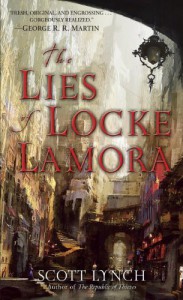 I’ve always enjoyed a good adventure tale—swords, boots, sailing ships. These days, many of those are found in the Fantasy genre and often include some magic or monsters as well. Scott Lynch’s Lies of Locke Lamora fits the bill with the added bonus of a caper. This book is the first in an on-going series, currently three volumes long and looking toward a fourth in 2016. Our protagonist, Locke Lamora, has been raised by a Fagin-esque mentor as a well-educated thief and swindler in a late medieval alternate universe of city states. Much of the action involves Locke and his pals (gang?) cleverly swindling an aristocrat while becoming entangled in lethal underworld wars. Think “Ocean’s Eleven” in tights mixed with a little “Gangs of New York” and a helping of “Game of Thrones.” The twisty fast-moving plot and the charm of the characters carry the book along. Some of the violence is extreme, and the language is salty—although inventive. I listened to the audio version, narrated by Michael Page. The other books in the series are Red Seas Under Red Skies and The Republic of Thieves.
I’ve always enjoyed a good adventure tale—swords, boots, sailing ships. These days, many of those are found in the Fantasy genre and often include some magic or monsters as well. Scott Lynch’s Lies of Locke Lamora fits the bill with the added bonus of a caper. This book is the first in an on-going series, currently three volumes long and looking toward a fourth in 2016. Our protagonist, Locke Lamora, has been raised by a Fagin-esque mentor as a well-educated thief and swindler in a late medieval alternate universe of city states. Much of the action involves Locke and his pals (gang?) cleverly swindling an aristocrat while becoming entangled in lethal underworld wars. Think “Ocean’s Eleven” in tights mixed with a little “Gangs of New York” and a helping of “Game of Thrones.” The twisty fast-moving plot and the charm of the characters carry the book along. Some of the violence is extreme, and the language is salty—although inventive. I listened to the audio version, narrated by Michael Page. The other books in the series are Red Seas Under Red Skies and The Republic of Thieves.
Friday Reads: The Whites by Richard Price, writing as Harry Brandt
“When I was in prison, I was wrapped up in all those deep books. That Tolstoy crap – people shouldn’t read that stuff.”
–Mike Tyson
The Whites, by Richard Price writing as Harry Brandt (more on that later) tells the familiar story of police detectives chasing criminals. The story mostly follows main character detective Billy Graves (still on the force but relegated to the night shift after some mishaps) and his cop friends (who have all left the force). Each of them has their own “white”, which is a reference to the white whale or Moby Dick. In this case the white is the one person that they believe got away with a brutal crime, but whose guilt cannot concretely be proved. Thus, their white roams free, escaping any societal punishment. Instead of tracking them down, injecting them with M99, encasing them in plastic, giving them their just desserts in a way not suitable for the squeamish (think power tools) and then dumping them into the ocean ala Dexter Morgan, the detectives just remain haunted by the open cases and continue to work the system to try and develop a new lead or evidence to connect the dots. Ho-hum. At least until the whites start turning up dead; certainly not in Dexter Morgan fashion, but dead nonetheless. And Price navigates the moral waters of such a course in a more typical way, at least compared to the morality of Dexter Morgan.
The thing about Price is that there is nothing new in the story or the formula (including a thrilling side story), but where Price excels is in the way he describes the ordinary dialogue and events of these somewhat (at least for cops) ordinary people. It’s what made his previous novels and his writing on The Wire so raw, real, engaging, and so darkly humorous.
Finally, why do we have “Richard Price writing as Harry Brandt”? Here’s Price’s explanation:
“I wrote it under a pseudonym because I intended to write a straight-up urban thriller — which I’ve never done before — and I wanted to have a separate persona for it. However, the book kept expanding and became like any other book I’ve written, so looking back, I wish I hadn’t used a pen name.”
Long story short: Nothing new here, but if you liked his other stuff you’ll like this one. Price also mentioned other writers who adopted pen names and who seemed to morph into those roles with distinction. Although this apparently was his idea from the start (to morph into a literary alter ego), he mentioned that he never really felt that way. Call him what you want (Harry, Richard, Guy, or Fella), but if you go into it knowing that The Whites isn’t any of that “Tolstoy crap” (and not expecting it), you might enjoy it just a little bit.
Friday Reads: Ghost Train to New Orleans
Zombies, vampires, ghosts, demons, and other undead citizens like to go on vacation, just like you and me. And, when they visit a new city, they also use travel guides to find the best activities and locations to check out. But, they can’t use just any travel guide. There are certain things that nonhumans need to know about the cities they visit – there are resources and establishments that cater specifically to them. Zoe Norris edits those kinds of travel guides for Underground Publications, a company that specializes in producing travel guides for the coterie, as the nonhumans prefer to be called. 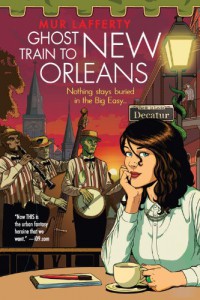
Ghost Train to New Orleans is the second book in The Shambling Guides series written by Mur Lefferty. In what I know will upset many other readers, I read this book first. New Orleans is one of my favorite cities to visit, so I jumped on it first. The first book is The Shambling Guide to New York City. There are many references to the first volume throughout Ghost Train to New Orleans, and some of them could be considered spoilers, but they didn’t have a detrimental effect on my enjoyment of this book. They just made me want to read the first one even more!
After the success of her first travel guide to New York City, Zoe and her co-workers are sent to New Orleans to research the sequel. What could be a relaxing trip ends up being anything but. Her boyfriend is slowly turning into a zombie, the city is trying to talk to her about a new threat to Zoe, and her writing team of vampires, death goddess, Valkyrie, and dragon just can’t get along with each other.
I found this urban fantasy to be a really fun read. The supernatural characters are creatively written, not at all what you’d expect. And the descriptions of New Orleans and use of the city in the storyline were perfect. I’m already planning my next trip there, and will definitely be checking out some of the locations that Zoe visited. Maybe I’ll even see some of her readers on holiday.
Friday Reads: How to Babysit a Leopard by Ted & Betsy Lewin
Ted and Betsy Lewin take turns recounting some of the many experiences they had while traveling the globe in order to research different animals and locations for the books they have written for children. Some events were frightening – som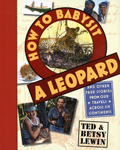 e humorous, all retold for the reader to share the back seat during their lives on the road in Africa, India, Mongolia and more – covering six continents!
e humorous, all retold for the reader to share the back seat during their lives on the road in Africa, India, Mongolia and more – covering six continents!
Plenty of their sketches from the trips as well as photographs are included on each two-page spread. I enjoyed reading about Africa, somewhere I have been, as well as the many places I have not! This book may inspire future travelers, artists, and writers. What amazing lives they have led!
Friday Reads: Ready Player One by Ernest Cline
I’m not sure I consider myself a child of the 80s, but I’m certainly old enough to appreciate the vast majority of the pop culture references in Ernest Cline’s Ready Player One. From Ferris Bueller to Geddy Lee, Max Headroom to Dungeons & Dragons, Monty Python to Back to the Future, there’s a bit of 80s nostalgia for everyone in this story. I listened to the audiobook (one of the pleasures of a long daily commute), narrated by Wil Wheaton.
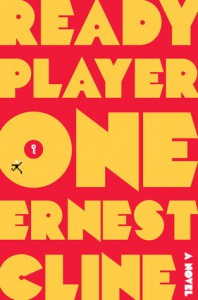 The year is 2044. Our hero, Wade, is an 18-year-old orphan living in the stacks – an overgrown trailer park where the mobile homes are literally stacked sky-high. Things are not going so great for Wade “IRL” (in real life), but that’s OK! Wade spends most of his waking hours in the OASIS, a sprawling online utopia that most of the population of Earth relies on to escape the crumbling mess that the real world has become. When the OASIS’s creator, game designer James Halliday, passed away, he promised control of the OASIS and his vast fortune (in the hundreds of billions) to the first person who can find the “Easter Egg” he has hidden inside this virtual world. The catch? The egg hunters or “gunters”, as they’ve been come to be known, must possess enough knowledge of 1980’s trivia to decipher the clues Halliday has sprinkled throughout the OASIS. It’s been 5 years and no one has found the first clue that will begin the game and lead to the ultimate prize… Until one day Wade stumbles upon it, putting his name at the top of the game’s scoreboard and making him both a legend among gunters and a target for the ruthless corporation that has its sights set on taking over the OASIS.
The year is 2044. Our hero, Wade, is an 18-year-old orphan living in the stacks – an overgrown trailer park where the mobile homes are literally stacked sky-high. Things are not going so great for Wade “IRL” (in real life), but that’s OK! Wade spends most of his waking hours in the OASIS, a sprawling online utopia that most of the population of Earth relies on to escape the crumbling mess that the real world has become. When the OASIS’s creator, game designer James Halliday, passed away, he promised control of the OASIS and his vast fortune (in the hundreds of billions) to the first person who can find the “Easter Egg” he has hidden inside this virtual world. The catch? The egg hunters or “gunters”, as they’ve been come to be known, must possess enough knowledge of 1980’s trivia to decipher the clues Halliday has sprinkled throughout the OASIS. It’s been 5 years and no one has found the first clue that will begin the game and lead to the ultimate prize… Until one day Wade stumbles upon it, putting his name at the top of the game’s scoreboard and making him both a legend among gunters and a target for the ruthless corporation that has its sights set on taking over the OASIS.
If you enjoy fast-paced humorous science fiction (even if you’ve never picked up a joystick), grab this one before it hits the big screen in the not-too-distant future.
Friday Reads: So You’ve Been Publicly Shamed
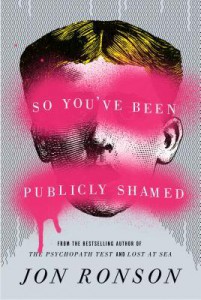 In history’s darker days, ne’er-do-wells were marched to public squares, sometimes by mobs waving torches or pitchforks, and displayed publicly as punishment. Here in 2015, most of us don’t have pitchforks or torches at home. But almost all of us have Facebook or Twitter or Reddit accounts. We also have the same basic impulses that drove extrajudicial justice in the past.
In history’s darker days, ne’er-do-wells were marched to public squares, sometimes by mobs waving torches or pitchforks, and displayed publicly as punishment. Here in 2015, most of us don’t have pitchforks or torches at home. But almost all of us have Facebook or Twitter or Reddit accounts. We also have the same basic impulses that drove extrajudicial justice in the past.
This is where Jon Ronson’s latest book begins. Times and tools have changed, but people haven’t. Some people still exhibit offensive (if not really criminal) behavior—plagiarism, insensitive jokes, outright lying. And some other people don’t like it and aren’t afraid to use the tools at hand to do something about it.
It’s probably never been fun to be publicly shamed. But, in the past, you’d eventually stop riding the rail, or go home and wash the tar and feathers off. At worst, you could move to a different village. Public shaming on the Internet has a bit more permanence. How do you ever move forward with your life when your bad deed has been retweeted thousands of times? How do you get a new job when that employer Googles your name and sees very cringeworthy images?
This book answers these questions and (re)introduces the reader to some famously shamed people. Those who have read Ronson’s The Psychopath Test and exquisite Them: Adventures with Extremists will recognize his narrative multitasking and brisk style. For a book with such substance, this is an exceptionally quick read—you can finish it in an afternoon—and it’s worth your time. The anonymous “mob justice” aspect of the Internet, which sometimes gets things extremely wrong, continues to grow anyway (and probably won’t be limited to shaming only the worst offenders). This book is all about that behavior and might make you rethink your next Send, Like, or Share.
Friday Reads: The Haunting of Hill House by Shirley Jackson
The Haunting of Hill House tells us the story of Eleanor an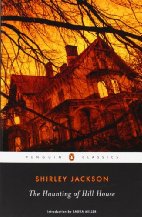 d her visit to Hill House, where she has been invited to take part in the exploration of its possible haunting. Eleanor is in a bad place in a sad life as she travels to the house—she has been the caretaker for her recently deceased mother, and her remaining family is caught up with their own busy lives, and they don’t seem to care about her health or well-being. At Hill House, she meets colorful characters she never would have met otherwise. There is Dr. Montague, who wants to scientifically quantify any eerie occurrence they find, to finally connect science and the supernatural. There is Theodora, who is a free spirit who seems to have figured out a lot of things about life that continue to baffle Eleanor, but who still doesn’t have all the answers. And there’s Luke, who will inherit Hill House someday, and all the baggage the house represents—and symbolizes. The group of psychic adventurers has to work out their interpersonal dynamics with each other and with newcomers.
d her visit to Hill House, where she has been invited to take part in the exploration of its possible haunting. Eleanor is in a bad place in a sad life as she travels to the house—she has been the caretaker for her recently deceased mother, and her remaining family is caught up with their own busy lives, and they don’t seem to care about her health or well-being. At Hill House, she meets colorful characters she never would have met otherwise. There is Dr. Montague, who wants to scientifically quantify any eerie occurrence they find, to finally connect science and the supernatural. There is Theodora, who is a free spirit who seems to have figured out a lot of things about life that continue to baffle Eleanor, but who still doesn’t have all the answers. And there’s Luke, who will inherit Hill House someday, and all the baggage the house represents—and symbolizes. The group of psychic adventurers has to work out their interpersonal dynamics with each other and with newcomers.
Jackson’s novel is a quick read of, as Dorothy Parker says in the blurb on the back, “beautifully written, quiet, cumulative shudders.” The text can be enjoyed as a breezy distraction, or there are plenty of plot points to reflect upon if the reader wishes. For example, Eleanor has been invited to the house by Dr. Montague because of a psychic experience as a child—what does it mean to have been a “special” child who grows up to be an adult that seems quite ordinary? How much can we rely on childhood memories and how do they affect us? How do we use memories to reconstruct traumatic family events?
This is one of those stories that will have you questioning what the characters believe—and will inspire you to think about what is really frightening in life. Ghosts? Loneliness? Bad architecture? Home ownership? Letting someone else do your thinking for you?
The Haunting of Hill House is a great example of the female gothic novel, where issues affecting women are explored through the themes of gothic literature. These themes include the influence of place, power dynamics, our struggle to reconcile logic with nature, and the reliability of memory, among other interesting issues.
This novel was adapted to make the 1963 movie The Haunting, which is enjoyably stylish but less nuanced than the novel. (The movie was remade in 1999 with an impressive cast and poor result.) Shirley Jackson is also the author of many other novels and stories, including “The Lottery,” which you may have had to read in school. If you already appreciate Shirley Jackson, you might enjoy this quiz: http://the-toast.net/2015/04/20/how-to-tell-if-you-are-in-a-shirley-jackson-story/
Friday Reads: Make Your Home among Strangers by Jennine Capó Crucet
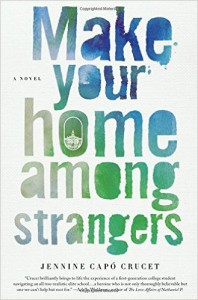 In this excellent debut novel by a newly transplanted Nebraska author, Jennine Capó Crucet demonstrates that she is a gifted writer who can create strong multi-dimensional characters. Relocating to Nebraska from Miami, she teaches English and Ethnic Studies at the University of Nebraska-Lincoln.
In this excellent debut novel by a newly transplanted Nebraska author, Jennine Capó Crucet demonstrates that she is a gifted writer who can create strong multi-dimensional characters. Relocating to Nebraska from Miami, she teaches English and Ethnic Studies at the University of Nebraska-Lincoln.
In Make Your Home among Strangers: A Novel, Lizet leaves Miami to venture north to an Ivy League school for her first year of college. The change in climate is not the only thing she has to get used to in her new environment. Besides adjusting to a very different life—academic and social—she has to traverse some unanticipated emotional territory. Learning to live with people with very different backgrounds and expectations than she’s ever been exposed to is just one part of the adjustment process. She also has to manage her own feelings about those she left at home—and maybe left behind? (And what a great colorful crew of well-developed, interesting characters they are!) Lizet has to decide how much her sense of responsibility for family and friends at home will trump her own needs—where the past ends and her future begins. She has to deal with managing her own expectations about her ability to help and steer the ones she loves vs. her ability to do this for herself in her own life.
All of this is explored in the context of very engaging storytelling and true-to-life dialog. We come to really care about Lizet and her family. I found myself really cheering for them all by the end of the book. This story is fun to read and I really enjoyed the author’s wicked observations of human nature—portrayed with gentle humor, not malice. There’s a fascinating sub-plot about what goes on in Miami’s Little Havana while Lizet is away at school and it leaves the reader wanting more of that story about Lizet’s family and friends. I hope I get to read about what happens next for them. Welcome to Nebraska, Jennine Capó Crucet. We can’t wait to read the rest of your stories.
This would be a good book for library book clubs. They would have a great time reading this book—and talking about it. Maybe you could even persuade the author to come to your library to make a presentation. I would love to come to that program!
Friday Reads: Paul Theroux’s The Great Railway Bazaar
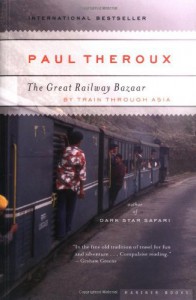 Why would a person be interested in reading a book published forty years ago? It doesn’t seem that is old enough to be considered a “classic,” and, to a degree, the author is not one of current list of “hot” authors that everyone wants to pick up. Still, there are often reasons to read a book not on a current best seller list that have less to do with the author, the subject, the title, the whatever. In this case it was a “waste not, want not” situation. I’d purchased this book over two years ago on a trip out of the country (It cost 187 “I-don’t-know-whats,”), I’d had it sitting around and had recently run across it again while winnowing my book collection to decide what to give to Lincoln City Libraries as donations.
Why would a person be interested in reading a book published forty years ago? It doesn’t seem that is old enough to be considered a “classic,” and, to a degree, the author is not one of current list of “hot” authors that everyone wants to pick up. Still, there are often reasons to read a book not on a current best seller list that have less to do with the author, the subject, the title, the whatever. In this case it was a “waste not, want not” situation. I’d purchased this book over two years ago on a trip out of the country (It cost 187 “I-don’t-know-whats,”), I’d had it sitting around and had recently run across it again while winnowing my book collection to decide what to give to Lincoln City Libraries as donations.
A little history here — I’ve always been interested in trains. Our first home (my twin sister’s and mine) was an apartment a couple of stories above the local public library in Emmaus, Pennsylvania, with the back “yard” a steep bank falling away to railroad tracks on which heavy rail cars clanked their way by. Our second home was an old place (Built in 1879 by A. & H. Hoerhammer) on Railroad Street, with those same railroad tracks now a narrow street and a less-steep bank away from our front door. So, you see, I couldn’t help but be, if not interested, at least steeped in the noise, smells, etc. first of steam locomotives, then diesel monsters as their rushed or crawled by our house.
But back to the book. The Great Railway Bazaar recounts author Theroux’s four-month journey, mostly by rail (with a few legs of the journey by ship and plane) all the way from Great Britain, to Japan and back. Most critics consider this book Theroux’s greatest achievement, but he has also written fiction — Jungle Lovers, Saint Jack, and perhaps more famous, The Mosquito Coast, several of these having been made into films.
If you choose to read this book, you will find the author highly entertaining (of the “laugh-out-loud” variety) at times. Other times he comes across as too critical of an entire culture (a little too much generalization at times), and at other points in the book very incisive. He doesn’t shrink from controversy and tackles just about anything, not excluding himself from criticism when he feels it is needed.
I do not doubt his sometimes shocking descriptions of life in a number of the countries he rides through. The most interesting feature of the book, however, is seeing how his descriptions of life on the various trains he takes reflect the countries and cultures they are riding through, and how he is affected by those forces. (“The railway bazaar, with its gadgets and passengers, represented the society so completely that to board it was to be challenged by the national character.”) But at other times the train travel itself, especially on journeys that lasted for days at a time, the author expresses his pleasure: “Train travel animated my imagination and usually gave me the solitude to order and write my thoughts. I travelled easily in two directions, along the level rails while Asia flashed changes at the window, and at the interior rim of a private world of memory and language.”
Of course, so many years later his descriptions are probably woefully out-of-date for a number of the countries he passed through, although I have to admit that some of them still appear quite incisive today. (For example, the Shah is still in power in Iran; the U.S. is just pulling out of the war in Vietnam. In Saigon a local woman tries to get the author to take a “half-American” baby with him. In Japan he experiences a noodle soup (“ra-men”) for the first time, probably one of the earliest mentions of that ubiquitous food in American writing.)
One of the most entertaining aspects of this book for me was that it dragged me decades back to my time as a not-very-good English major in college. The book is loaded with literary and historical allusions, making me want to go back to books I missed (or didn’t finish reading) all those years ago, and savor them with the passage of time and their relationship to this book. The author also captures the essence of really long-distance travel, especially to foreign countries when he says, “. . . the scenes changing in the train window from Victoria Station to Tokyo Central are nothing compared to the change in himself; and travel writing, which cannot but be droll at the outset, moves from journalism to fiction, arriving . . . at . . . autobiography.” And in this he is in good company with both Mark Twain and Henry James.
Try it. I think you’ll like it!
Richard Miller
Friday Reads: The Antidote by Oliver Burkeman
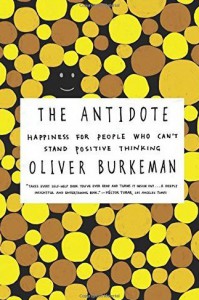 My original intention was to write a bit about the Wisdom of Insecurity, authored by Alan Watts and published in 1951. The reasons for this include the fact that I just recently read it, and Watts demonstrates a directness and clarity that is refreshing. The book reads like it could have been written today:
My original intention was to write a bit about the Wisdom of Insecurity, authored by Alan Watts and published in 1951. The reasons for this include the fact that I just recently read it, and Watts demonstrates a directness and clarity that is refreshing. The book reads like it could have been written today:
“Human beings appear to be happy just so long as they have a future to which they can look forward – whether it be a ‘good time’ tomorrow or an everlasting life beyond the grave. For various reasons, more and more people find it hard to believe in the latter. On the other hand, the former has the disadvantage that when this ‘good time’ arrives, it is difficult to enjoy it to the full without some promise of more to come. If happiness always depends on something expected in the future, we are chasing a will-o’-the-wisp that ever eludes our grasp, until the future, and ourselves, vanish in the abyss of death.”
And …
“For this stream of stimulants is designed to produce cravings for more and more of the same, through louder and faster, and these cravings drive us to do work which is of no interest save for the money it pays-to buy more lavish radios, sleeker automobiles, glossier magazines, and better television sets, all of which will somehow conspire to persuade us that happiness lies just around the corner if we will buy one more.”
Well, the appeal of Watts (described in many circles as playing a large role in bringing eastern philosophy to a western crowd) is not just in the one-liners. His writing appears to come at least somewhat from the perspective of the ever increasingly trendy “living in the moment” prescription, but also is perhaps at least a precursor to the deeper notions and variants of nondualistic pantheism. After reading Watts, it seemed fairly easy to sum these major points up; I was looking for something with a bit more depth. Oliver Burkeman’s the Antidote provides a little more of that. I say a little because much of what Burkeman writes about is quite similar to Watts, but there is some new material here that is worthwhile. Burkeman’s ideas might at least be a decent starting point.
Burkeman’s title provides some degree of a play on words (whether intended or not) in that the antidote he describes is something to counteract one’s unhappiness and the fact that he provides numerous anecdotes throughout the book. Burkeman draws from many sources, largely from the work of Stoicism and Albert Ellis and smally on things like the Museum of Failed Products, the self-help industry, Zen Buddhism, meditation, Mt. Everest climbers, Eckhart Tolle, and memento mori. Burkeman makes good arguments against the preoccupation with goals, less intensive planning, and ditching the modern day “cult of optimism.” Burkeman notes that “it is our constant efforts to eliminate the negative – insecurity, uncertainty, failure, or sadness – that is what causes us to feel so insecure, anxious, uncertain, or unhappy.”
It might be easy to conclude that Burkeman is advocating negative thinking. He’s not. There is a clear differentiation between negative thinking and the prescribed (stoic) rational thinking.
One perplexing notion, at least to me and requiring further thought and reflection is this aforementioned notion of “living in the moment”. It seems to me that consciousness plays a large role in it, and if a person is consciously thinking about something (including living in the moment), can they really be doing or experiencing it? If we perpetually read books, attend seminars, or participate in groups that bring this idea front and center, can we ever really achieve it under those circumstances? Probably not, and I think Watts would agree: “To understand music, you must listen to it. But so long as you are thinking, ‘I am listening to this music,’ you are not listening.” At any rate, if you are looking at an alternative to the positive thinking machine, the Antidote might prove to be a good read, and might turn you on to some other thought provoking stuff.
Friday Reads : The Glassblower by Petra Durst-Benning
“In the village of Lauscha in Germany, things have been done the same way for centuries. The men blow the glass, and the women decorate and pack it. But when Joost Steinmann passes away unexpectedly one September night, his three daughters must learn to fend for themselves. Feisty Johanna takes a practical approach to looking for work, Ruth follows her heart, aiming to catch a handsome young villager”, and quiet Marie develops her talent for glassblowing. This title, by Petra Durst-Benning, and originally published in Germany, is the first in the Glassblower Trilogy. I was fascinated by the description of the intricacies of glass-blowing, the process of how artist’s wares were bought and sold in late 1800’s Germany, and of course, the sister’s trials and tribulations through it all.
Friday Reads: The Goblin Emperor by Katherine Addison
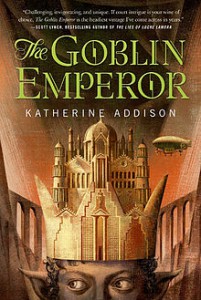 It’s the story of the unwanted, unloved fourth, and extra son of an elven Emperor, who unexpectedly, violently, becomes the next emperor. With no training and no one to trust, he’s thrust into a fully imagined court and political wrangling of a complex government that he hasn’t even been fully educated about. On top of all that, he is half Goblin, a distrusted minority in his country. The unexpected part of the story is that, of course, that living with a greedy, selfish, violent guardian has taught him survival skills that he can use. And he has more than a few. And despite all the difficulties, the story is a hopeful one.
It’s the story of the unwanted, unloved fourth, and extra son of an elven Emperor, who unexpectedly, violently, becomes the next emperor. With no training and no one to trust, he’s thrust into a fully imagined court and political wrangling of a complex government that he hasn’t even been fully educated about. On top of all that, he is half Goblin, a distrusted minority in his country. The unexpected part of the story is that, of course, that living with a greedy, selfish, violent guardian has taught him survival skills that he can use. And he has more than a few. And despite all the difficulties, the story is a hopeful one.
The author has not only packed the story with the edgy subject of race, and all the differences that can mean, but many other lines that she handles well. The accident that ends his father, the emperor’s life, and the lives of his three older half brothers, was aboard an airship (dirigible). Two people are set to guard the emperor at all times, one his soul and the other his body. But the one who guards his soul can also cast what we would call spells. New ideas are part of the difficulties the new emperor must deal with, including a new bridge. There is also an ongoing investigation into the deaths of his father and half brothers, which threads through the story, as well as 2 assassination attempts.
The world building is wonderful. One can tell where the origins of many of the foundations come from, but the author handles them in ways that seem fresh. While magic and steam punk flourishes exist, the story, the politics, the struggles, and the people are more interesting. In many ways though, it feels more like a historical story, than a fantasy, despite that fact that the character’s ears move to indicate their emotional state, much like a cat’s.
Katherine Addison, is actually a pseudonym for Sarah Monette.
The novel has received the Locus Award for Best Fantasy Novel and nominated for the Nebula, Hugo and World Fantasy Awards.
Reviews:
Strange Horizons: The Goblin Emperor by Katherine Addison, reviewed by Foz Meadows
Building Bridges: The Goblin Emperor by Katherine Addison reviewed by Liz Bourke
Friday Reads: Boys Don’t Knit (In Public), by T.S. Easton
 “Meet Ben Fletcher: Accidental criminal. Liar. Master of mohair.” So proclaims the cover of UK author T.S. Easton’s delightfully silly YA novel Boys Don’t Knit. Ben Fletcher is a 17-year-old good kid and worrier, who gets drawn into an act of juvenile delinquency by his misfit friends. Ironically, considering he was the most reluctant participant, and due in part to a series of unfortunate circumstances, Ben winds up in the most trouble when they’re caught. Placed on probation, Ben is required to keep a journal (hence the diary-format of the novel) and to take an evening class at the local community college.
“Meet Ben Fletcher: Accidental criminal. Liar. Master of mohair.” So proclaims the cover of UK author T.S. Easton’s delightfully silly YA novel Boys Don’t Knit. Ben Fletcher is a 17-year-old good kid and worrier, who gets drawn into an act of juvenile delinquency by his misfit friends. Ironically, considering he was the most reluctant participant, and due in part to a series of unfortunate circumstances, Ben winds up in the most trouble when they’re caught. Placed on probation, Ben is required to keep a journal (hence the diary-format of the novel) and to take an evening class at the local community college.
Due to limited choices, he winds up as the only male student in an introductory knitting class. (Other options included a car maintenance class taught by his father; pottery taught by the mother of a female classmate he has a crush on; and Microsoft Office for beginners, which he describes as being “for grannies and people who’ve just arrived in civilization after having been raised by wolves in the Appalachians.”) The challenge for Ben is how to keep his participation in the knitting class a secret from his father, who wants Ben to share his manly interest in soccer, cars, and World War II, and his classmates.
Of course, Ben winds up being a natural talent at knitting, so much so that he is drafted to participate in the regional heat of the All-UK Knitting Championship, in the junior category. He also ends up REALLY LIKING knitting, not only the social aspects of class, but also the calming effect it has on his mind. It begins to take over his life: He listens to knitting podcasts; furtively reads knitting magazines at the store (hiding a girly magazine inside the knitting magazine when he sees his friends approaching so they’ll think that’s what he’s really looking at, when it’s actually the other way around); and even sets up an Etsy shop. Eventually, despite his best efforts, he’s “outed” at school by an administrator wanting to capitalize on his success as a young entrepreneur. As you can imagine, this leads to constant ribbing from friends and enemies alike, and while it is painful to Ben it makes for amusing reading.
There is a lot of humorously cringe-worthy material in this book (intentional on the part of the author) which we, the readers, get to experience along with Ben (though as readers we are in a better position to be tickled by it than Ben). This includes conversations between Ben’s parents, which are filled with food-based double entendres that used to go over Ben’s head but now cause him no end of psychic pain. We also get to read excerpts of his friend Joz’s horribly-written novel-in-progress, titled Fifty Shades of Graham, which he’s having Ben proofread. It contains winning lines such as “Her large chest heaved angrily at me.” All in all, Ben has a lot of crosses to bear. His voice, as he shares his experiences with us via his diary entries, is as delightful and appealing as can be, making this a wonderful romp of a read.
Easton, T.S. Boys Don’t Knit (In Public). New York: Feiwel and Friends, 2015.
Friday Reads: All the Light We Cannot See by Anthony Doerr
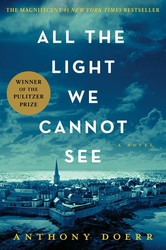 Anthony Doerr’s book “All the Light We Cannot See” (Simon & Schuster) won the Pulitzer Prize for fiction in 2015. I listened to the audio version on a long road trip and read parts of the text version. I tend to avoid hyperbole but I’ll venture without reservation that this is an extraordinary book and I enjoyed it. I’ll go further and say that Doerr’s writing is exquisite. A New York Times bestseller for many months, it is deserving of the attention it has received. World War II and Nazi occupied France provide the setting for “All the Light We Cannot See.”
Anthony Doerr’s book “All the Light We Cannot See” (Simon & Schuster) won the Pulitzer Prize for fiction in 2015. I listened to the audio version on a long road trip and read parts of the text version. I tend to avoid hyperbole but I’ll venture without reservation that this is an extraordinary book and I enjoyed it. I’ll go further and say that Doerr’s writing is exquisite. A New York Times bestseller for many months, it is deserving of the attention it has received. World War II and Nazi occupied France provide the setting for “All the Light We Cannot See.”
The book follows the lives of a blind French girl named Marie-Laure and a gifted German boy named Werner who has a special talent for radio technology. Their stories run parallel and eventually converge. Doerr devoted ten years to writing the book and wrote two others during that time. Doerr’s extensive research is notable. The book is sentimental, and in a good way. This is a lyrical and intricate book with a highly readable format. I’ll be interested in whatever he publishes next.
Friday Reads: Consumed by Fire, by Anne Stuart
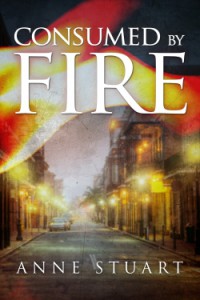 From the publisher’s blurb: “As an assassin for the Committee, a covert agency dedicated to stamping out international crime, [James Bishop] had no business even thinking about marriage. But it was the only way to protect Evangeline after she’d unwittingly wandered into his operation against a group of human traffickers.”
From the publisher’s blurb: “As an assassin for the Committee, a covert agency dedicated to stamping out international crime, [James Bishop] had no business even thinking about marriage. But it was the only way to protect Evangeline after she’d unwittingly wandered into his operation against a group of human traffickers.”
Not all blurbs sum up a book that well, but this one tells a potential reader what she needs to know. Does he desert her, and then return to rescue her because he just can’t resist her any longer? Of course. Is she hurt and angry and suspicious of him, but so in love that she’ll forgive him? Was it really a question?
Anne Stuart is known for bad boy heroes. She’s also known for snappy dialog, fast-paced plotting, steamy interludes, and pushing the envelope. The book read so quickly that I didn’t think about the general improbability of it all and just enjoyed the ride. I’d recommend it to James Bond fans.
This title, the first in the new “Fire” series, continues the world of Ms. Stuart’s popular “Ice” series. It carries the Montlake Romance imprint, part of Amazon publishing. It’s available for Kindle, in audio, or in paperback.

